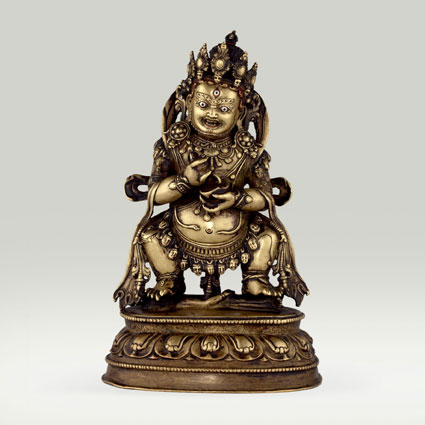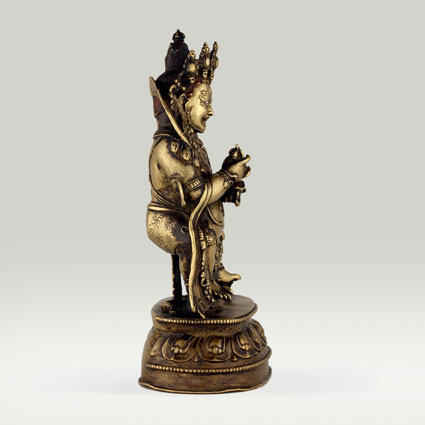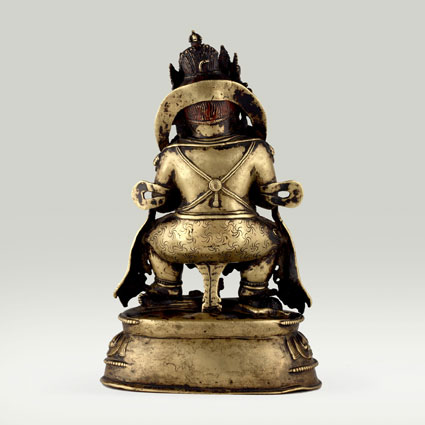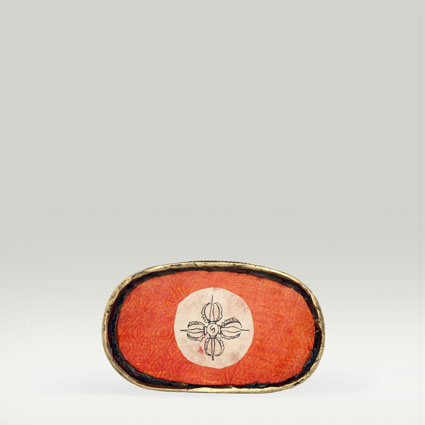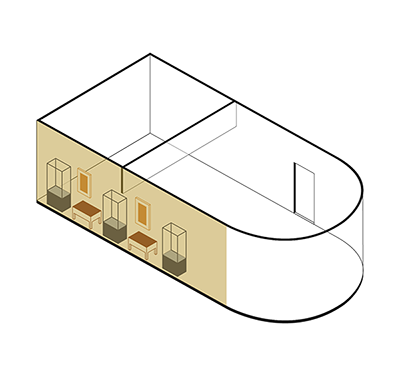
ABS 048
Code: ABS 048
Country: Tibet (central)
Style:
Date: 1400 - 1500
Dimensions in cm WxHxD: 13.7 x 22 x 8.1
Materials: Brass; inlaid with silver and copper
Two-armed form of Mahakala - the "Great Black" known in Tibet as Gur gyi mgon po ("gurgy gonpo")
Hollow cast in two parts.
The three eyes are inlaid with ‘silver’ and copper, the pupils filled with a black lacquer-like black paint.
The lips are inlaid with copper.
The ornamentation of the jewellery is worked without inset precious stones.
The face retains no traces of painted cold gold, but the hair has traces of a red pigment.
The rim above the lotus petals is decorated with engraved floral ornaments.
The bottom of the pedestal is not sealed.
This two-armed form of Mahakala is known as Panjaranatha Mahakala. This deity is identified by some writers as the “Protector of the Tent”, because the Sanskrit term panjara with the meaning of “cage or pavilion” was translated as gur, the Tibetan term for “tent”. The attribute laid across the arms is a wooden gong (dharmagan i).
Panjara Mahakala (Tib. Gur gyi mgon po), three-eyed with a fierce expression, is trampling with spread legs on a corpse placed upon a single lotus pedestal. He holds with the right hand a chopper (karttrka) and with the left hand a skull-cup (kapala). The baton (gandi) originally carried across the crooks of his elbows is broken. Mahakala wears a five-fold crown decorated with skulls, is bedecked with jewellery and snake ornaments, and wears a garland of skulls (mundamala). He is also wearing an animal hide and the “investiture with the sacred thread” in the shape of a snake (nagopavita). Note the vajrafinal on top of the tall knot of hair.
The Sadhanamala (SM) contains eight sadhanas with four variations of Mahakala under various names: one face and two arms as Dvibhuja Mahakala (SM 300, 301, 302, 306); one face and four arms as Caturbhuja Mahakala (Tib. mGon po phyag bzhi pa) (SM 303, 305); one face and six arms as Sadbhuja Mahakala (Tib. mGon po phyag drug pa) (SM 304); eight faces, four legs and sixteen arms as Sodasabhuja Mahakala (SM 312). In Tibet, another two-armed form known as Panjara Mahakala, or Mahakala Panjaranatha (Tib. Gur gyi mgon po or Gur mgon) represents an important tutelary deity of the Sa skya pa tradition. This deity is identified by some writers as the “Protector of the Tent”, because the Sanskrit term panjara with the meaning “cage or pavilion” was translated as gur, the Tibetan term for “tent”. The attribute laid across the arms is not the pole of a tent but a wooden baton (gandi) used to strike the hour in a Buddhist monastery. The Tibetan canonical literature distinguishes a number of additional forms of Mahakala.
(From Wikipedia, the free encyclopedia)
Mahakala is a Dharmapala("protector of dharma") in Vajrayana Buddhism (Tibetan Buddhism and Japanese Shingon Buddhism).
In Japanese Buddhism, Mahakala (Jpn: Daikoku), belongs to the fourth hierarchy of deities (tenbu).
Name
Mahakala is a Sanskrit bahuvrihi of maha ("great") and kala ("black"). The Tibetan name is Gonpo Phyag (Wylie: mGon po phyag ).
Description
Mahakala is relied upon in all schools of Tibetan Buddhism. However, he is depicted in a number of variations, each with distinctly different qualities and aspects. He is also regarded as the emanation of different beings in different cases, namely Avalokiteshvara (Tib: Chenrezig) or Chakrasamvara (Tib: Korlo Demchog, Wylie: ’khor-lo bde-mchog).
Mahakala is typically black in color. Just as all colors are absorbed and dissolved into black, all names and forms are said to melt into those of Mahakala, symbolizing his all-embracing, comprehensive nature. Black can also represent the total absence of color, and again in this case it signifies the nature of Mahakala as ultimate or absolute reality. This principle is known in Sanskrit as "nirguna", beyond all quality and form, and it is typified by both interpretations.
Mahakala is almost always depicted with a crown of five skulls, which representing the transmutation of the five kleshas(negative afflictions) into the five wisdoms.
The most notable variation in Mahakala's manifestations and depictions is in the number of arms, but other details can vary as well. For instance, in some cases there are Mahakalas in white, with multiple heads, without genitals, standing on varying numbers of various things, holding various implements, with alternative adornments, and so on.
Manifestations
Six-Armed Mahakala
The Six-Armed Mahakala (Skt: Shad-bhuja Mahakala, Wylie: mGon po phyag drug pa) is favored by the Gelug order of Tibetan Buddhism, and in this manifestation is considered to be a fierce and powerful emanation of Avalokitesvara, the bodhisattva of compassion.
He is adorned with the following symbolic attributes:
1. The Six Arms signify the successful completion of the six perfections (shad-paramita), which are practiced and brought to perfection by bodhisattvas during the course of their training.
2. various implements in each hand.
There is also a White Six-Armed Mahakala (Skt: Shad-bhuja Sita Mahakala; Tib. Wylie: mGon po yid bzhin nor bu) popular among Mongolian Gelugpas. In this case, he is a "wealth deity", specifically supporting the comfort and economic well-being of tantric practitioners. As such, his iconography differs in form and symbolism, with his skull bowl containing various jewels rather than the typical mortal remains of his victims, and a crown of jewels instead of skulls. The following description is found in his sadhana: "His body is white. His face is wrathful, and he has three eyes. He has six arms. His main right hand holds a wish-fulfilling jewel (cintamani) mounted on a jewel-tipped handle, in front of his chest."
Four-Armed Mahakalas
Various Four-armed Mahakalas (Skt. Chatur-bhuja Mahakala, Tib. Wylie: mGon po phyag bzhi pa) are the primary protectors of the Karma Kagyu and Drikung Kagyu schools of Tibetan Buddhism. A four-armed Mahakala is also found in the Nyingma school, although the primary protector of the Great Perfection (Skt: Mahasandhi, Tib. Dzogchen) teachings which are the pinnacle of the Nyingma system is Ekajati.
The four arms of this manifestation of Mahakala perform one of the following four positive karmas or actions, which are said to be his specific boon to his worshippers:
* Pacify sickness, hindrances, and troubles.
* Increase life, good qualities and wisdom.
* Attract whatever Dharma practitioners need and bring people to the Dharma.
* Destroy confusion, doubt, and ignorance.
Two-Armed Mahakalas
The two-armed Mahakala called Bernakchen is a protector of the Karma Kagyu school. It is often thought to be the primary protector, but it is actually the main protector of the Karmapas specifically.
Panjaranatha Mahakala, 'Lord of Charms" or "Lord of the Pavilion", an emanation of Manjushri is a protector of the Sakya order.
Béguin, Gilles, 2013. Art sacré du Tibet – Collection Alain Bordier, [catalogue of the exhibition held at the Fondation Pierre Bergé – Yves Saint Laurent; 14 mars au 21 juillet 2013]. Paris: Fondation Pierre Bergé – Yves Saint Laurent. Editions Findakli. Pp. 175 - 176
Bock, Etienne; Falcombello, Jean-Marc; Jenny Magali, 2022. Trésors du Tibet. Sur les pas de Milarépa.. Paris: Flammarion. p. 74
de Mallmann, Marie-Thérèse, 1975. Introduction à l'iconographie du tântrisme bouddhique. Paris: Adrien Mainsonneuve (Jean Maisonneuve successeur (1970). Pp. 238-239
de Nebesky-Wojkowitz, René, 1956. Oracles and Demons of Tibet: The Cult and Iconography of the Tibetan Protective Deities. s’Gravenhage: Mouton & Co. Pp. 38–67
Kelényi, Béla, 1994. “Panjara Mahakala: A Tibetan Painted Scroll from the Delar Collection”, Ars Decorativa, Vol. XIV. Ars Decorativa. Pp. 88–98, 5 figs - References to the cult of Panjara Mahakala in Tibet
Kreijger, Hugo E. , 1989. Godenbeelden uit Tibet: Lamaïstische Kunst uit Nederlands particulier bezit [catalogue of the exhibition held in the museum voor Volkenkunde in Rotterdam]. Den Haag: Gegevns Koninkljike Bibliotheek. P. [94]: Mahakala. Central Tibet, 16h–17th century
Lo Bue, Erberto and Ricca, Franco, 1990. Gyantse Revisited. Firenze: Casa Editrice Le Lettere & Torino: Cesmeo. Pp. 201, 203–4
Pal, Pratapaditya, 1977. “The Lord of the Tent in Tibetan Paintings”, Pantheon, Vol. XXXV, No. 2. Pantheon. Pp. 97–102, 9 figs - References to the cult of Panjara Mahakala in Tibet
Sèngué, Tcheuky, 2002. Petite Encyclopédie des Divinités et symboles du Bouddhisme Tibétain. Editions Claire Lumiere . Pp. 322-324
Stoddard, Heather, 1985. “A Stone Sculpture of mGur mGon-po, Mahakala of the Tent, Dated 1292”, OANS, Vol. XXXI, No. 3. Oriental Art, New Series. Pp. 278–82, 2 figs - References to the cult of Panjara Mahakala in Tibet
von Schroeder, Ulrich and von Schroeder, Heidi, 2009. Tibetan Art of the Alain Bordier Foundation. Hong Kong: Visual Dharma Publications. Pp. 42 - 43
Wang, Yao, 1994. “A Cult of Mahakala in Beijing”, Proceedings of the 6th Seminar of the International Association for Tibetan Studies, Fagernes 1992. Edited by P. Kvaerne. Oslo: The Institute for Comparative Research in Human Culture. Pp. 957–964 - References to the cult of Mahakala in China

